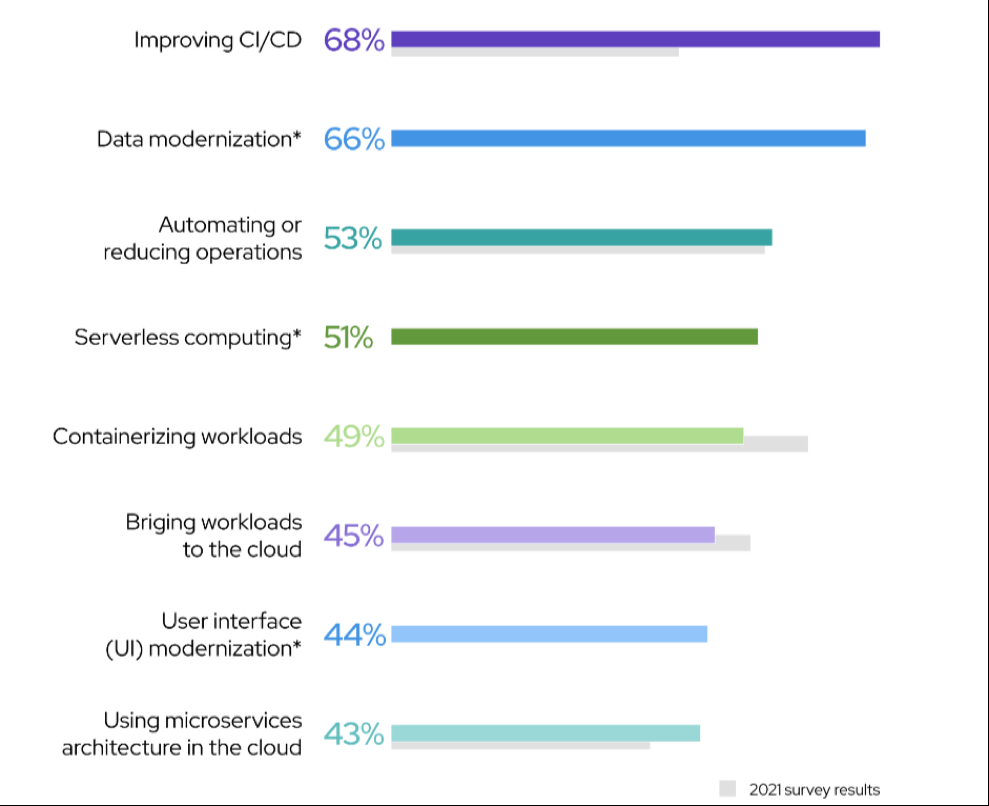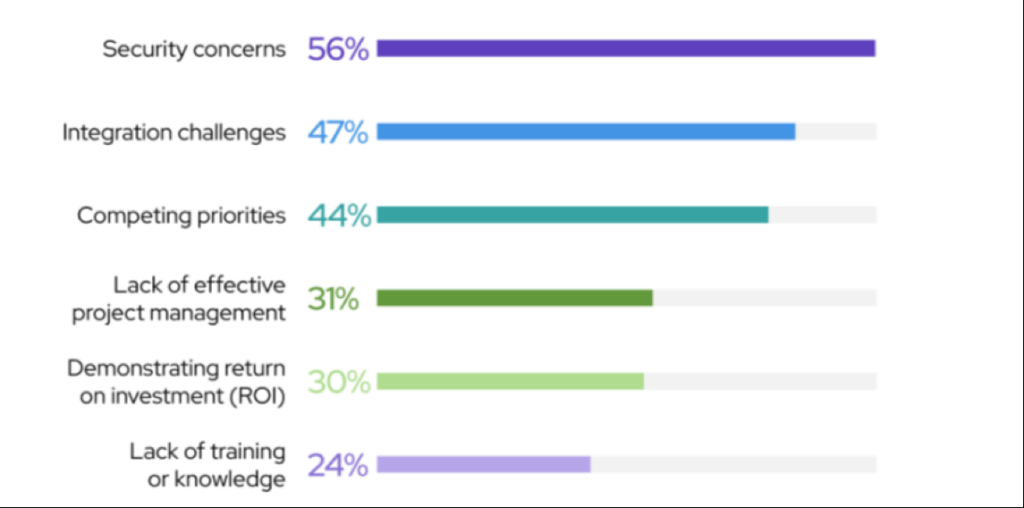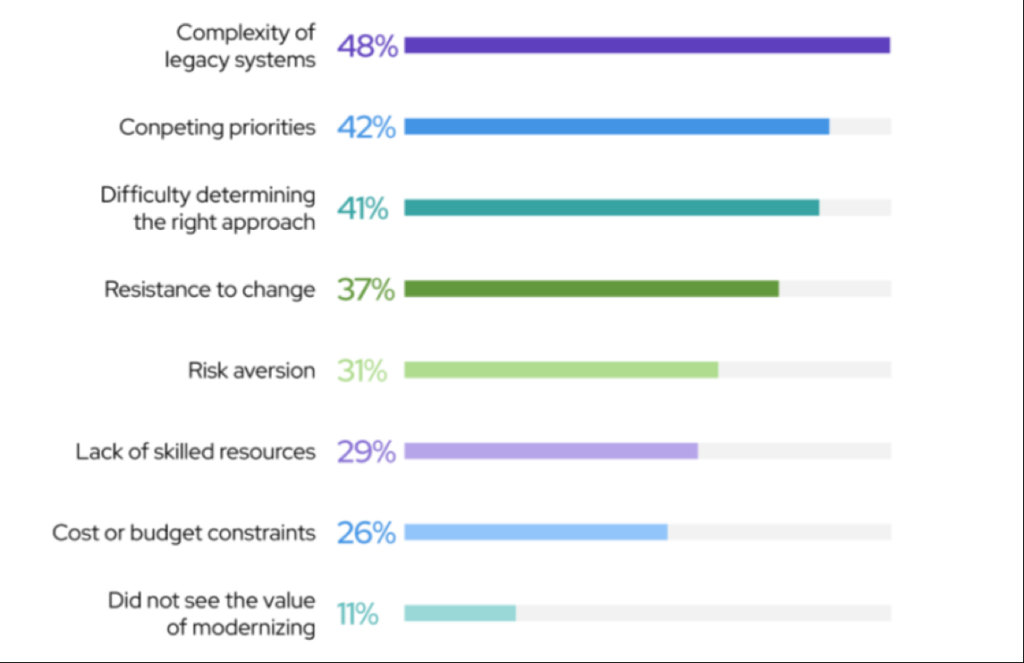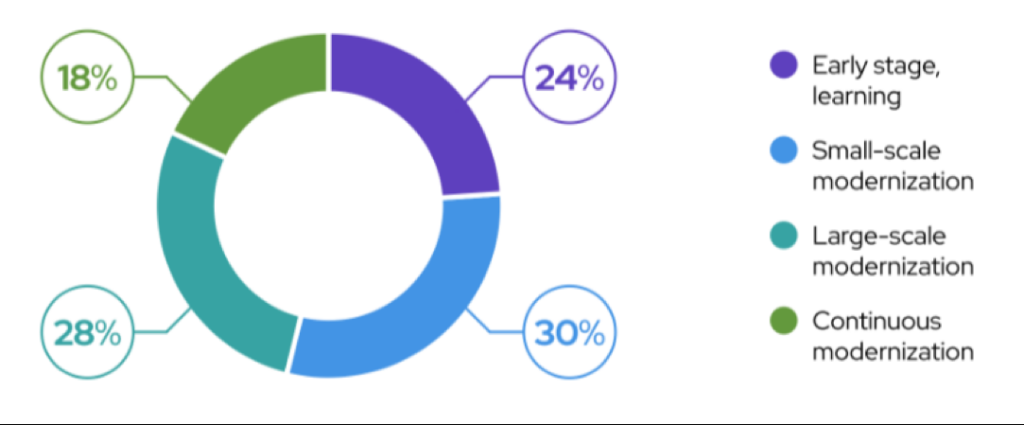Contents
Legacy systems may have become critical to your daily operations, but the cost and other implications of maintaining them often outweigh their benefits. From rising technical debt to other indirect costs, they pose a burden and a long-term challenge for businesses.
Modernizing legacy applications emerges as a definitive solution to controlling these costs while aiming for either (or all) of these three things:
- Improve Interoperability and Scalability
- Reduce Maintenance Costs and Technical Debt
- Future Readiness
However, the path to modernization isn’t simple—security risks, integration challenges, stakeholder resistance, and demonstrating ROI are common obstacles. If these concerns resonate with you, read on to learn how others are steering through similar challenges. Let’s begin by going over the true costs of maintaining a legacy system.
The Cost of Maintaining Legacy Systems
Legacy systems once formed the foundations of traditional IT infrastructures, making businesses reliant on extensive hardware setups for critical processing and data storage. These systems were often built with certain compromises or shortcuts made in software development, often due to tight deadlines or budget constraints.
These compromises, like using outdated code, result in some form of “debt” within legacy systems. Over time, the cost of this debt, similar to interest on a financial loan, adds up to the cost. It makes maintenance more expensive, leaves room for security vulnerabilities, and requires more challenging upgrades.
Other Indirect Costs
- Slower Release Cycles
Maintaining legacy systems often means dealing due to outdated, poorly documented code and tightly packed dependencies. This slows down your development and testing processes, leading to longer release cycles and delayed product updates.
- Lowered Morale
Developers working on legacy systems may face frustration due to outdated tools, withdrawn vendor support, convoluted codebases, and repetitive maintenance tasks. This lowers team morale and overall productivity.
- Opportunity Costs
Focusing resources on maintaining legacy systems can divert attention and a significant portion of your budget away from innovation and new projects, leading to missed opportunities for growth and lesser innovation.
Overcoming the Costs: Legacy Application Modernization
A great way to cut down on the above expenses is to modernize legacy applications and systems.
Modernizing legacy applications aims to enhance their performance and security, improve maintainability, and ensure they are future-proof by being compatible with evolving technologies. But how you go about modernization can vary based on your system’s needs. For example, if your company is dealing with outdated data in siloed storage, data modernization will be a key part of your overall modernization approach. Similarly, modernization is also considered as:
- Improving CI/CD
- Automating (or reducing human operations)
- Serverless Computing
- Containerizing Workloads
- Bringing Workloads to the Cloud
- UI Modernization
- Using Microservices in the Cloud
As per the second Red Hat report on the State of Legacy App Modernization, the majority of the respondents link modernization with improving CI/CD for better software delivery (68%), modernizing their data (66%), and automation (53%). Here is a visual comparison of their perceptions in 2021 with those collected in 2024.

Why Modernize Legacy Apps?
Successful legacy system transformations can bring numerous long-term benefits.
- Increased (Future) Development Speed: Modernized apps use modern frameworks like the cloud and modular architectures like microservices, allowing teams to work independently and release updates faster, from practically anywhere. This enhances agility and accelerates future development, enabling quicker response to market changes.
- Decreased Maintenance Costs: Modern systems are easier to maintain, with fewer software or security patches, easier upgrades, and lower operational costs. They are built with updated, well-supported technologies and frameworks, making them less prone to vulnerabilities and inconsistencies found in outdated code. Upgrades are also simpler due to modular architectures like microservices, where individual components can be updated without affecting the entire system.
- Increased Scalability: Modernized apps are often containerized (through Docker and Kubernetes) for easy maintainability and hosted on the cloud, allowing them to flexibly adjust resources based on demand. Moreover, leading cloud platforms like AWS, GCP, and Azure also provide customizable auto-scaling features, eliminating the need for costly hardware investments or over-provisioning in busier periods.
Such benefits allow you to pay a significant portion of your “technical debt” back. This is because replacing outdated code and poor architecture with scalable, efficient systems reduces future risks and complexity.
Challenges in Legacy Application Modernization
Regardless of benefits, implementing a legacy application modernization solution is an intricate process, not free from its own challenges.
Security Concerns
Modernizing legacy applications with outdated security protocols can expose them to evolving security threats. For instance, migrating them to the cloud or microservices architectures may introduce new attack vectors, such as unsecured APIs, misconfigured access controls, or vulnerabilities in data encryption during migration. Moreover, legacy systems may not support modern security patches, making it harder to safeguard sensitive data.
Integration Challenges
Legacy Systems often use outdated technologies, proprietary protocols, or hardcoded connections that are incompatible with modern systems. Integrating them with new platforms or cloud services can lead to broken workflows, data inconsistencies, or performance bottlenecks. For example, legacy databases might not be compatible with modern data formats or not support real-time data exchange, causing delays in synchronization.
Competing Priorities
In many organizations, especially those with stringent budget constraints, legacy application modernization solutions often have to compete with ongoing operational tasks such as maintaining current applications, ensuring uptime, etc. This often pushes them to go with piecemeal upgrades instead of a holistic transformation.
Lack of Effective Project Management
For effective modernization, you need proactive management that prevents potential roadblocks due to unclear deliverables or misaligned business and technical teams. Consider this, a lack of coordination between development, operations, and security teams can lead to conflicting goals, such as focusing on speed over security.
Fun Fact: That’s where DevOps comes in handy to ensure a modernization project’s success.
Demonstrating ROI
Measuring the success of an application modernization project is not very straightforward, especially when the benefits, such as increased agility or reduced technical debt, are not immediately visible. Stakeholders may question the value of the investment if there are no clear, quantifiable short-term gains.
Lack of Training Knowledge
Transitioning from legacy systems to more advanced systems or platforms requires expertise in both the old system and the new technologies being implemented, such as cloud computing, modern storage solutions, microservices, or containerization. However, many companies struggle to have all the expertise, their IT teams may lack proficiency in newer technologies or modern DevOps practices. Similarly, they may not have enough knowledge of the legacy software, limiting their ability to shift data or workflows.
As per the same report, below is a representation of individual perceptions of app modernization challenges:

As evident, more than half (56%) of the people (ITDMs, backend developers, or software architects) agreed with having concerns about application/system security when considering legacy system transformation. 47% were also doubtful about successful integrations post-modernization.
Organizations, as a whole, had a slightly different view of legacy app modernization projects.

While competing priorities and lack of skilled resources come as common legacy app modernization challenges, organizations are seemingly more bound by complexities (48%), modernization approaches (41%), and budgets (26%). In fact, almost 11% of organizations did not seem to be interested yet.
The Current State of Legacy App Modernization
Despite these challenges, rapid tech advancements have pushed the majority of companies to at least begin with modernization in some areas. Consequently, almost 24% (of the respondents or their organizations) were in the early stages of the process. Here is a rough breakdown:

How Has AI Impacted Legacy Application Modernization?
It is evident that legacy application modernization is a complex and time-consuming process. Moreover, the high cost and inefficiencies have held many businesses back from making permanent updates to their legacy systems. But with AI in the mix, most of these challenges can be easily and efficiently addressed. In fact, over 90% of business owners now see AI as inevitable for modernizing their systems.
Identifying Legacy Code to be Modernized
AI tools like DeepCode, CAST, and OpenAI Codex can help in the identification and analysis of code that needs legacy software modernization. These tools use complex algorithms to assess code quality and flag areas prone to security vulnerabilities or performance issues.
Data Transfers
AI has improved data transfer efficiency by automating and optimizing how data is moved between systems. It can analyze and spot data inconsistencies after the modernization process. AI-driven data transfer solutions can also intelligently prioritize and automate data extraction from legacy systems, transform it to fit modern data models, and load it into new environments with minimal manual intervention.
Performance Optimization
AI can also help in optimizing performance by monitoring resource usage, application responsiveness, and transaction times. Based on this data, it can provide actionable insights on where improvements are needed. Additionally, AI can also suggest further configurations, such as adjusting memory allocation or rebalancing workloads for consistent performance.
Automated Testing
AI-powered software testing tools like Selenium, Testim, and Applitools can be used to automate regression testing, unit testing, and UI testing during app modernization. These tools use ML algorithms to automatically generate test cases, identify defects, and adapt to changes in the codebase.
Code Assistance
In legacy software modernization projects, AI-powered coding assistants like GitHub Copilot, ChatGPT, and Tabnine can suggest code snippets, complete functions, and recommend best practices. These tools learn from vast codebases and offer context-aware suggestions, helping developers write cleaner, more efficient code and reducing the time required for manual coding.
Wrapping it up
Legacy application modernization has become a priority for several businesses. While some legacy apps continue to function without major updates and modernization, many others struggle to keep performing. And the only feasible solution to keep them running is to modernize them, wholly or partially. That said, the process can still feel overwhelming, requiring careful planning, time, and dedicated resources. For most, it is an ongoing journey rather than a one-time project. This is why many companies prefer getting professional legacy application modernization services to ensure successful, cost-effective migration. These service providers have experts who assess your current structure, devise a phased modernization plan to minimize downtime, and provide a dedicated team for your project.

